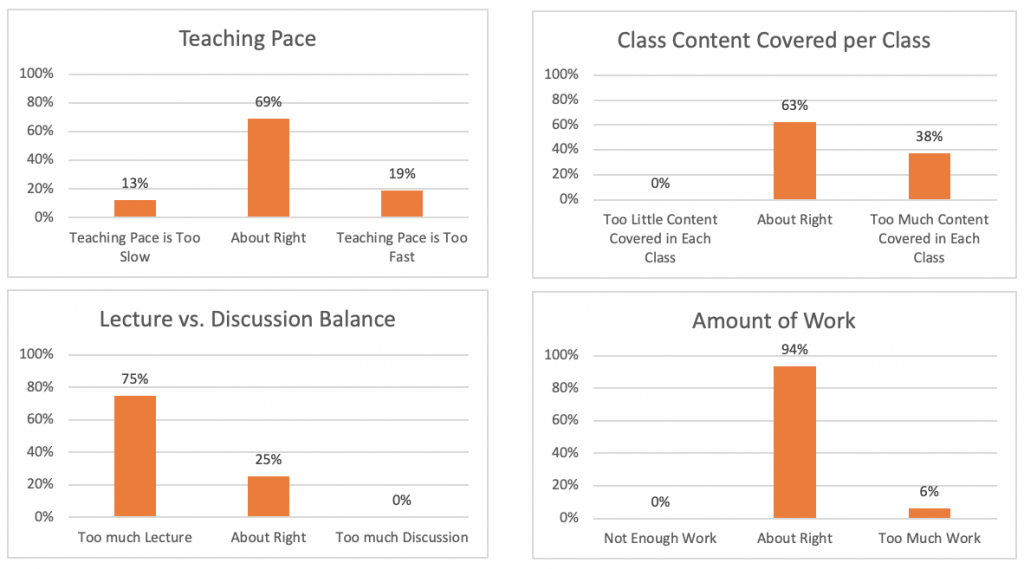Collecting mid-semester student feedback allows you to build upon the strengths of your course and address potential areas for improvement. Even the most talented instructors can gain insights from student feedback, but please only collect mid-semester feedback if you intend to address it with your students. This does not mean you have to make all of the suggested changes, but you do need to acknowledge that you’ve heard the students’ comments.
Matthew Bunyi, who leads learning assessment initiatives at the Sanford School of Public Policy, stresses that mid-semester feedback is designed to inform small adjustments, not massive changes.
“Some instructors worry that the implications of mid-semester feedback will change everything that they’re doing. That’s not the goal. Instead, by collecting feedback strategically, you will end up with a small number of direct action items.”
-Matthew Bunyi, Director of Executive Education at the Duke Center for International Development
What information should I collect?
The Trinity College of Arts & Sciences identifies three key questions that mid-semester course evaluations should aim to address:
- What aspects of class are going well and what needs improvement?
- What changes in the course would benefit student learning?
- What are the mid-semester benchmarks that will help you interpret end-of-term data?
Methods for collecting feedback
In this blog post, we will address three different ways to obtain feedback from your students:
When choosing how to measure your students’ perceptions of your course, consider which aspects of your teaching you are most eager to probe. For instance, a student survey might give you a comprehensive snapshot of the overall student experience. Peer observation, on the other hand, can provide more nuanced critique of your content delivery or use of technology during class.
| Course instruction | Classroom dynamics | Assignments and feedback | Course policies | Instructional technologies | |
| Student survey | X | X | X | X | X |
| Small Group Instructional Feedback (SGIF) | X | X | X | X | X |
| Peer observation | X | X | X |
Student survey
Mid-semester feedback can be easily collected through online, anonymous surveys. Qualtrics is a survey tool available free for Duke users through a university-wide license. The Office of Assessment has provided a library of questions, available within Qualtrics, for instructors to use as they develop their own mid-semester course evaluations. Follow this guide to access the library of questions created by the Office of Assessment. For more inspiration, check out the UC Berkeley sample questions for midterm course evaluations.
Matthew Bunyi developed a survey that probes four aspects of the student experience: Teaching pace, class content, lecture/discussion balance, and amount of work. Bunyi recommends using the “Goldilocks scale” (too much, too little, just right) rather than the Likert scale (agree/disagree from 1-5) because the Goldilocks scale suppresses outliers and is easy to interpret. His four-question survey, which is administered using Qualtrics, has been adopted by many instructors in the Sanford School of Public Policy.

As another example of a mid-semester student survey, see a survey that was created by the Grand Valley State University Math Department (this was created using Google Forms, but Duke instructors could make something similar with Qualtrics).
Small Group Instructional Feedback
Small Group Instructional Feedback (SGIF) is a formative check-in process designed to gather information from your students on how your course supports their learning. First, Learning Innovation facilitators will schedule a time to come to your class (in-person or virtually). Then, for 20-30 minutes, the facilitators will ask students to form groups and answer predetermined questions about your course (you will be absent during this time). Next, the facilitators will synthesize feedback in a way that preserves students’ anonymity. Finally, within a few days of the class interview, the facilitators will meet with you to debrief. As the instructor, you will receive synthesized, constructive feedback so that you can make targeted adjustments while your course is still in progress.
One advantage of SGIF is that, unlike surveys, group sessions provide the opportunity for students to hear their peers’ perceptions of the course, which might contextualize their own understanding of course materials or policies. During the interview, the facilitators will solicit alternative perspectives and assess consensus for each discussion point raised. This process reduces outlier points of feedback. Feedback sessions are always voluntary and confidential.
If you are interested in scheduling a Small Group Instructional Feedback, please complete the request form.
Peer observation
Getting feedback from a colleague or other trained observer can often provide useful insight or new ideas for addressing instructional challenges. Duke Learning Innovation offers detailed suggestions for arranging a peer observation session in this blog post from spring 2021.
Peer observers can also be former students (see this post by a philosophy professor at the University of Wisconsin at Madison about his experience having a student critique his teaching). Employing prior students to conduct the observation is advantageous because the students understand the unique challenges that students face in the course. They are well equipped to provide perspective on why students might be struggling.
Responding to feedback
Once you’ve collected student feedback, it’s time to analyze the data. The analysis and sharing protocol should be shared with students ahead of time so that there are no surprises or breaches of confidentiality. Once you have the feedback in-hand, explain to students how you intend to respond to their feedback. Which requests for change will you honor? Are there any misunderstandings that need to be addressed?
Seize the opportunity to highlight what is working well, and clarify your rationale for using certain strategies or technologies. Inevitably, some feedback will not yield direct changes to the course, either because it is too late or because the request is unrealistic. In these cases, explain to your students why no action will be taken.
Resources
For more resources on collecting mid-term feedback, read this blog post or check out Learning Innovation’s guide to teaching assessment.
